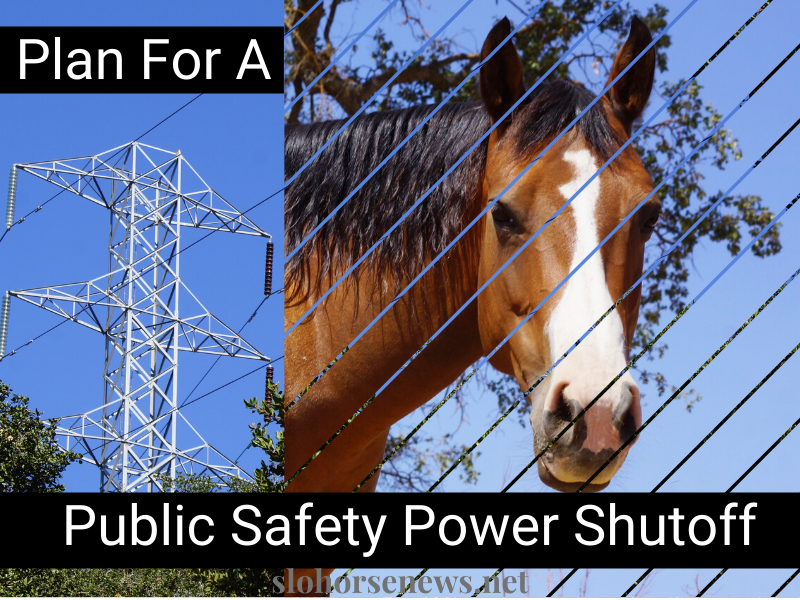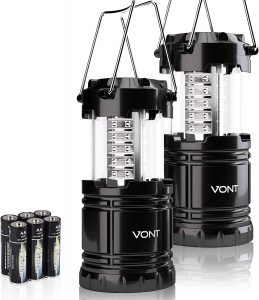The wind has picked up, the humidity is low, the weather is warm, your horse’s coat may be getting fuzzy. . . it’s the height of the California fire season. PG&E may prescribe a Public Safety Power Shutoff to lower the fire danger. Do you have a human and horse survival plan for a power shutoff?
Human and Horse Two Step Survival Plan for a Power Shutoff
High winds, low humidity and high heat are three of the weather triggers for an advance-notice Public Safety Power Shutoff (PSPS) event, decided by California electrical service providers. A wildfire could trigger an immediate shut off plus an evacuation. Parts of our county could be affected or the whole area. Much of the decision is based on transmission lines delivering electricity to our county. Nonetheless we must be prepared and have a human and horse survival plan for a power shutoff.
Are you prepared to leave your animals with a pet sitter? Help communicate all the vital care instructions with a Horse and Pet Care Communication Checklist.
How will a PSPS affect the occupants of your homes and your barns?
STEP ONE: INFORMATION
Get Advance-Notice for Public Safety Power Shutoff
Electrical providers will attempt to provide a 72-24 hour advance warning, however if the weather changes suddenly or a fire breaks out there may be no advance warning. So be prepared, especially during extreme fire weather conditions.
Information Resources
For the most up-to-date info regarding a PSPS check
- PG&E website
- SLO Office of Emergency Services Facebook page
- SLO County Emergency Management website
- Sign-up for alerts
- HEET
Community Impact of a Public Safety Power Shutoff
In the event of a Public Safety Power Shutoff an entire community and neighboring communities will be impacted. Grocery stores will be closed. Gas stations will be closed. ATM machines will not work. Water supply and sewage treatment will be affected. Electric gates, refrigerators and other electric appliances will not work. Plan for these events not only affecting your community but neighboring ones as well.
Hey, head’s up. Purchasing products through clicking the the links or product pics that follow may result in providing us a little kick-back money. To learn more see the affiliate disclaimer near the end of this story.
STEP TWO: SUPPLIES
An outage may be for a few hours or more than a week. Emergency shelters will not be engaged for a power outage, unless there is also an evacuation due to a fire. You must have supplies on hand for the duration of a power shutoff.
Water: Essential for Life
Watering systems which rely on electrical power will not operate without an alternative power source. Public water sources need electricity and none will be provided.
- Horses: 15-20 gallons of water is needed per day/horse.
- Humans: 1 gallon per person/day on average. More for exertion and cleaning.
- Other pets: Depends on size and level of activity of animal.
Water Storage:
Dating water storage containers and using the newest for consumption and the oldest for cleaning and other water needs, is a good way to cycle through your water storage. Water can be treated with drops of bleach to lengthen shelf life or place silver or copper bars in the bottom of the container. Water can also be run through a purifier. Do your own research here to determine what is best for your situation.
Horse Water Storage Options
- Clean food-safe trash cans (temporary storage)
- Water storage barrels
- Water buckets
- Large capacity water troughs
- Portable water tank
- Watertight feed bins
- Bathtub
Human/Small Animal Water Storage Options
Consider the weight of a full container for transportation.
It is recommended to have water stored so you will have water. Upon a 72-24 hour PSPS notice more water can be stored in additional temporary containers like open trash cans. The temporary water can then used for the event or if the event does not occur the water can be used anyway or for garden purposes.
Food: Necessary for Energy
Horses: Have at least a two-week supply of hay, grain, supplements and medications on hand above your normal rations.
Humans: Store 3-7 days supply of non-perishable foods for all members of your household. Keep in mind dry goods such as beans and rice will need water to bring them to a consumable state.
Household pets and other livestock: Ensure a two week supply of feed and water for their needs.
Cooking and Storing Food during a PSPS
- Employ an alternative cooking source such as a camping stove.
- Have extra butane fuel on hand.
- Be ready with a food preserving alternative such as a camping cooler.
- Keep perishable food cool with camping cool packs.
Communication, Power and Lights
You will need light and the ability to communicate.
Cell Phones
Cell towers will have power for a limited time. If the cell tower can not deliver a signal your cell phone will not work. A land line should work throughout if using copper lines (AT&T). Have a hard copy of your contact numbers in case you can’t access them digitally.
Lights
You will need portable light sources. Candle light is not recommended due to the fire hazard.
Here are some lights, power and communication items that will come in handy:
- Battery powered NOAA weather radio
- Portable solar charger
- Camping lanterns
- Flashlights
- Extra batteries for everything
Generators
A power generator for your home is very useful in a power outage. However, several things must be considered.
- What is the load capacity of the generator?
- Will the exhaust be away from people?
- Are the power cords the correct size for the power generated?
- Will power cords pose a tripping hazard or a fire hazard?
- Do you have fuel stored for the generator?
More Things to Consider
Cars and Trucks
Gas stations will be closed in a PSPS so don’t let your tank go below half full and fill up when an advance-notice is given.
Cash
ATM machines will not be operable so have cash on hand.
What to Do Once the Power Comes Back On
It’s a good idea to unplug appliances and tools during an outage to prevent spikes when the power comes back on. Leave one light on so you know when the power comes back on. Flip the switches off on your control box except for power to the one light. Label the control box so you know what switch supplies power to the major appliances or areas of your home/barn/garage.
When the power comes back on, don’t rush! Gradually turn essential appliances back on, then wait 10 to 15 minutes before reconnecting your other electronics to give your electrical system a chance to stabilize.
Discard any spoiled food items. Cook food which has begun to defrost.
Get to know your neighbors and help each other out.
Just so you know, clicking the above pictures and product links takes you to the product on the Riding Warehouse and Amazon websites. This makes shopping easy and convenient for you. We do get a little kick-back from items purchased, giving us resources to bring you more stories, but your price stays the same. It’s a win-win! Also for local riders, sometimes you can order items online and request pick-up – during checkout – at the Riding Warehouse store in San Luis Obispo. Happy Trails!
All of the above information is a merely a guide and may not provide everything you will need in the case of a power outage. Seek more information from reliable information sources.
A big thank you to Karen Jones of HEET for providing the horse survival information.
Cover Photo: Sharon Jantzen Photos
 When there is a Public Safety Power Shutoff parts of or the whole SLO County may be affected. You will need to hunker down at home. Be sure you have what you and your animals will need to survive with this FREE Power Shutoff Survival checklist. We’ll continue to add horsing around stories to our website. You can stay up-to-date by becoming a SLO Horse News herd member. Get your Power Shutoff Survival Checklist here >.
When there is a Public Safety Power Shutoff parts of or the whole SLO County may be affected. You will need to hunker down at home. Be sure you have what you and your animals will need to survive with this FREE Power Shutoff Survival checklist. We’ll continue to add horsing around stories to our website. You can stay up-to-date by becoming a SLO Horse News herd member. Get your Power Shutoff Survival Checklist here >.








